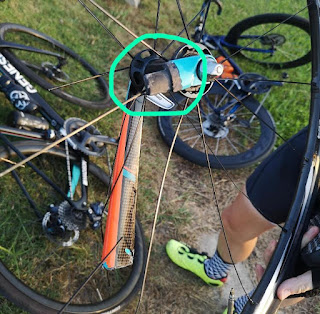I did my first triathlon when I was 16 years young. Coming from a cross country/ track and field background, my strongest leg was naturally the run. Though I finished somewhere in the middle of that race (there was only the open category then), I ended up with a run time that was among the top ten fastest.
My swim and bike time was closer to the bottom half naturally. Yes, I learnt to swim when I was seven and definitely rode a bike from time to time, but my swim/ bike timings in that race was not fast as I didn't have the specific training that I put in as a runner. Slow transitions and fumbling with my cycling cleats didn't help either.
It isn't surprising then that a particularly good performance in my run section will come at the cost of sub-par performances in the other two disciplines.
That's what I tried to explain to one of my triathlete patients (who swam competitively in school) who had an unusually fast swim but slower than normal bike and/or run splits in a recent race. Of course it may also be a simple question of pacing.
Other reasons may be genetic. His broad shoulders may work against him on the bike especially in the aerodynamics area and run for carrying the extra muscles in the upper body.
Unless you are a professional athlete, there will be a finite amount of time and energy to train. If you spend too much time on one discipline, it will be at the expense of the other two.
Sometimes, we don't observe the trade offs due to the "big houses, big cars" effect (Van Noordwijk and de Jong, 1986). Just because someone who spends a lot of money on a fancy car does not mean he/ she will not have enough money left to buy a fancy house and vice versa. In reality, we do know people who can afford big houses and many fancy cars to boot.
This scenario is usually more obvious in slower triathletes compared to faster triathletes in Ironman distances. For the triathletes with slower finishing times, faster than average bikers are very likely to have slower than average run splits and vice versa.
This is less likely as the overall finishing times get faster. In male triathletes who are capable of finishing sub nine hours, those with a faster than average bike split are also likely to have a faster than average run split. These are your athletes who can afford the "big fancy houses and big fancy cars".
The above pattern emerges when comparing different triathletes, and this may reflect differences in innate talent and/ or training levels.
However, while comparing multiple races from a single triathlete, results suggest that pacing strategies are more important. What researchers found in slower triathletes was recording a faster than usual bike time was associated with a slower than faster run time and vice versa.
The faster triathletes were not subject to this pattern. A good time on the bike did not necessarily mean a good or bad run time.
Exceptions are when you have a very good bicycle (a form of resource allocation) which can provide aerodynamic and mechanical advantages that don't have a trade off elsewhere (except your wallet).
Here's the simple truth, for mere mortals with normal jobs, with children especially, it's pretty much impossible to reach the starting line of an Ironman with sufficient / optimal preparation for all three disciplines.
References
Calsbeek R and Careau V (2019). Survival Of The Fittest: The Multivariate Optimization Of Performance Phenotypes. Med Sci Sports Ex. 51(2): 330-337. DOI: 10.1249/ MSS. 0000000000001788.
Van Noordwijk AJ and de Jong G (1986). Acquisition And Allocation Of Resourses: Their Influence On Variathlon In Life History Tactics. The Am Naturalist. 128(1): 137-142.
 |
| Me (left) at the 2005 SEA Games triathlon event |
When I was racing, during my peak training periods, I swam up to 20 km, rode 400 km and ran 70 km a week. All this for Olympic distance racing.
I'll wake up at 4.20 am, eat a little before leaving at 4.50 am. I'll ride to the pool where we plunge in at 5.30 am sharp. This was when I swam with Joseph Schooling, Quah Ting Wen etc under Centre of Excellence (COE) coach John Dempsey. We usually end at around 7 am after which I'll ride my bike to work at the old National Stadium. (Sometimes I have to treat some of my fellow swimmers before going to work).
If I'm up to it I would do a short run before showering and seeing my first patient at 8.30 am. This was when I was working full time as a physiotherapist at the Singapore Sports Council (Sport Singapore now).
No children then and a very understanding wife definitely helps. And we definitely didn't have a big house or a fancy car then and even now. We only bought a three year old car after my first boy turned one.
 |
| Here's a closer look at my bike then |



















